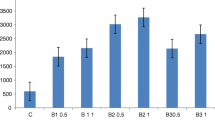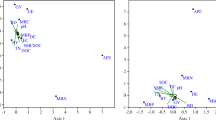Abstract
Biochar is carbonized biomass obtained from sustainable sources detained in soil to improve the fertility of agricultural soil. The porous nature and absorptive properties of biochar have the potential to immobilize elements, which provide an ideal environment for the soil biota that helps to enhance the growth of plants. In this study, different feedstocks such as sugarcane bagasse (SB), plant material (PM), and manure biomass (MB) were pyrolyzed for the production of biochar. Elemental contents of the feedstock’s and voucher were determined with the help of the atomic absorption mass spectrometer. Elemental concentration was significantly increased in biochars compared to raw materials. A pot experiment with 2% and 4% of each biochar was conducted on chili plant to elucidate the beneficial effects on plant growth as compared to control soil, the elemental analysis of the plant soil contained each biochar showed to progressively increase in the concentration of manganese (Mn), zinc (Zn), and copper (Cu) as these are trace elements and have important role in plant growth system. Microbial population in biochar amended soil was also evaluated to check the impact on bacterial populations. Soil with 2% biochar showed 16% increase in the microbial load while biochar with 4% increased the microbial population up to 50%. Furthermore, biochar treatments to red soil increased the elemental Cu, Mn, and Zn concentrations, respectively, and also increased the soil pH. Consequently, soil productivity increased in terms of plant growth by balancing the concentration of elements and also increased the microbial population. It is concluded that biochar use in agriculture could be effective for the soil fertility and increasing plant growth and soil bacteria.





Similar content being viewed by others
References
Antal MJ, Grønli M (2003) The art, science, and technology of charcoal production. Ind Eng Chem Res 42:1619–1640
Arora A, Sairam R, Srivastava G (2002) Oxidative stress and antioxidative system in plants. Curr Sci:1227–1238
Baldock JA, Smernik RJ (2002) Chemical composition and bioavailability of thermally altered Pinus resinosa (Red pine) wood. Org Geochem 33:1093–1109
Bourke MC, Brearley JA, Haas R, Viles HA (2007) A photographic atlas of rock breakdown features in geomorphic environments
Brodowski S, John B, Flessa H, Amelung W (2006) Aggregate-occluded black carbon in soil. Eur J Soil Sci 57:539–546
Carter S, Shackley S, Sohi S, Suy T, Haefele S (2013) The impact of biochar application on soil properties and plant growth of pot grown lettuce (Lactuca sativa) and cabbage (Brassica chinensis). Agronomy 3:404–418
de Vries W, Lofts S, Tipping E, Meili M, Groenenberg JE, Schütze G (2007) Impact of soil properties on critical concentrations of cadmium, lead, copper, zinc, and mercury in soil and soil solution in view of ecotoxicological effects. Rev Environ Contam Toxicol 191:47–89
Dai Z, Wang Y, Muhammad N, Yu X, Xiao K, Meng J, Brookes PC (2014) The effects and mechanisms of soil acidity changes, following incorporation of biochars in three soils differing in initial pH. Soil Sci Soc Am J 78(5):1606–1614
Dai Z, Zhang X, Tang C, Muhammad N, Wu J, Brookes PC, Xu J (2017) Potential role of biochars in decreasing soil acidification-a critical review. Sci Total Environ 581:601–611
Demirbas A (2004) Effects of temperature and particle size on bio-char yield from pyrolysis of agricultural residues. J Anal Appl Pyrolysis 72:243–248
Demirevska-Kepova K, Simova-Stoilova L, Stoyanova Z, Hölzer R, Feller U (2004) Biochemical changes in barley plants after excessive supply of copper and manganese. Environ Exp Bot 52:253–266
EPA U (1996) Method 3050B: acid digestion of sediments, sludges, and soils. Environmental Protection Agency: Washington
Gaspard S, Altenor S, Dawson EA, Barnes PA, Ouensanga A (2007) Activated carbon from vetiver roots: gas and liquid adsorption studies. J Hazard Mater 144:73–81
Graber ER, Harel YM, Kolton M, Cytryn E, Silber A, David DR, Tsechansky L, Borenshtein M, Elad Y (2010) Biochar impact on development and productivity of pepper and tomato grown in fertigated soilless media. Plant Soil 337:481–496
Gu M-y, Liu H-l, Li Z-q, Liu Z-w, Tang G-m, Xu W-l (2014) Impact of biochar application on soil nutrients and microbial diversities in continuous cultivated cotton fields in Xinjiang. Sci Agric Sin 47:4128–4138
Hammes K, Schmidt MW (2009) Changes of biochar in soil. Biochar environ manag: Sci technol 1:169–181
Hassink J, Bouwman L, Zwart K, Brussaard L (1993) Relationships between habitable pore space, soil biota and mineralization rates in grassland soils. Soil Biol Biochem 25:47–55
Hiller E, Fargašová A, Zemanova L, Bartal M (2007) Influence of wheat ash on the MCPA immobilization in agricultural soils. Bull Environ Contam Toxicol 79:478–481
Jeffery S, Verheijen FG, van der Velde M, Bastos AC (2011) A quantitative review of the effects of biochar application to soils on crop productivity using meta-analysis. Agric Ecosyst Environ 144:175–187
Jia R, Qu Z, You P, Qu D (2018) Effect of biochar on photosynthetic microorganism growth and iron cycling in paddy soil under different phosphate levels. Sci Total Environ 612:223–230
Joseph S, Amonette JE (2012) Characteristics of biochar: microchemical properties. Biochar for environmental management. Routledge, Abington, pp 65–84
Katare J, Pichhode M, Nikhil K (2013) Effect of different mining dust on the vegetation of District Balaghat, MP—a critical review. Int J Sci Res 4:603–607
Kumar N (1984) Effect of Zn XP fertilization on the growth of soyabean (Glycin max L.). M. Sc. Thesis, CS Azad University of Agriculture and Technology, Kanpur,
Kuzyakov Y, Subbotina I, Chen H, Bogomolova I, Xu X (2009) Black carbon decomposition and incorporation into soil microbial biomass estimated by 14C labeling. Soil Biol Biochem 41:210–219
Lehmann J, Rillig MC, Thies J, Masiello CA, Hockaday WC, Crowley D (2011) Biochar effects on soil biota–a review. Soil Biol Biochem 43:1812–1836
Lewis S, Donkin M, Depledge M (2001) Hsp70 expression in Enteromorpha intestinalis (Chlorophyta) exposed to environmental stressors. Aquat Toxicol 51:277–291
Loneragan JF (1988) Distribution and movement of manganese in plants. Manganese in soils and plants. Springer, pp 113-124
Marschner H (1995) Mineral nutrition of higher plants, 2nd edn. Academic Press, Cambridge
Martinsen V, Alling V, Nurida N, Mulder J, Hale S, Ritz C, Rutherford D, Heikens A, Breedveld GD, Cornelissen G (2015) pH effects of the addition of three biochars to acidic Indonesian mineral soils. Soil Sci Plant Nutr 61:821–834
Muhammad N, Brookes PC, Wu J (2016) Addition impact of biochar from different feedstocks on microbial community and available concentrations of elements in a Psammaquent and a Plinthudult. J Soil Sci Plant Nutr 16(1):137–153
Muhammad N, Hussain M, Ullah W, Khan TA, Ali S, Akbar A, Rizwan M (2018) Biochar for sustainable soil and environment: a comprehensive review. Arab J Geosci 11(23):731
Rafique M, Ortas I, Ahmed IA, Rizwan M, Afridi MS, Sultan T, Chaudhary HJ (2019) Potential impact of biochar types and microbial inoculants on growth of onion plant in differently textured and phosphorus limited soils. J Environ Manag 247:672–680
Rehman MZ, Rizwan M, Hussain A, Saqib M, Ali S, Sohail MI, Shafiq M, Hafeez F (2018) Alleviation of cadmium (Cd) toxicity and minimizing its uptake in wheat (Triticum aestivum) by using organic carbon sources in Cd-spiked soil. Environ Pollut 241:557–565
Rizwan M, Ali S, ur Rehman MZ, Adrees M, Arshad M, Qayyum MF, Ali L, Hussain A, SAS C, Imran M (2019) Alleviation of cadmium accumulation in maize (Zea mays L.) by foliar spray of zinc oxide nanoparticles and biochar to contaminated soil. Environ Pollut 248:358–367
Rizwan M, Ali S, Qayyum MF, Ibrahim M, Zia-ur-Rehman M, Abbas T, Ok YS (2016) Mechanisms of biochar-mediated alleviation of toxicity of trace elements in plants: a critical review. Environ Sci Pollut Res 23:2230–2248
Sheldon A, Menzies N (2005) The effect of copper toxicity on the growth and root morphology of Rhodes grass (Chloris gayana Knuth.) in resin buffered solution culture. Plant Soil 278:341–349
Sohi SP, Krull E, Lopez-Capel E, Bol R (2010) A review of biochar and its use and function in soil. Advances in agronomy. Elsevier, pp 47-82
Stadtman ER, Oliver CN (1991) Metal-catalyzed oxidation of proteins. Physiologic conseq J Biol Chem 266:2005–2008
Warnock DD, Lehmann J, Kuyper TW, Rillig MC (2007) Mycorrhizal responses to biochar in soil–concepts and mechanisms. Plant Soil 300:9–20
Warnock DD, Mummey DL, McBride B, Major J, Lehmann J, Rillig MC (2010) Influences of non-herbaceous biochar on arbuscular mycorrhizal fungal abundances in roots and soils: results from growth-chamber and field experiments. Appl Soil Ecol 46:450–456
Wu S (1994) Effect of manganese excess on the soybean plant cultivated under various growth conditions. J Plant Nutr 17:991–1003
Yruela I (2005) Copper in plants. Braz J Plant Physiol 17:145–156
Acknowledgements
Authors of this manuscript are highly thankful to the Higher Education Commission of Pakistan (HEC) for providing financial assistance.
Author information
Authors and Affiliations
Corresponding author
Additional information
This article is part of the Topical Collection on Implications of Biochar Application to Soil Environment under Arid Conditions
Rights and permissions
About this article
Cite this article
Ullah, Z., Ali, S., Muhammad, N. et al. Biochar impact on microbial population and elemental composition of red soil. Arab J Geosci 13, 757 (2020). https://doi.org/10.1007/s12517-020-05671-6
Received:
Accepted:
Published:
DOI: https://doi.org/10.1007/s12517-020-05671-6




